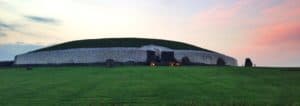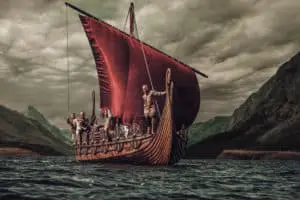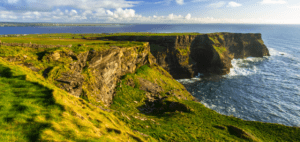The Palio di Siena: A Historic Horse Race Tradition Unveiled
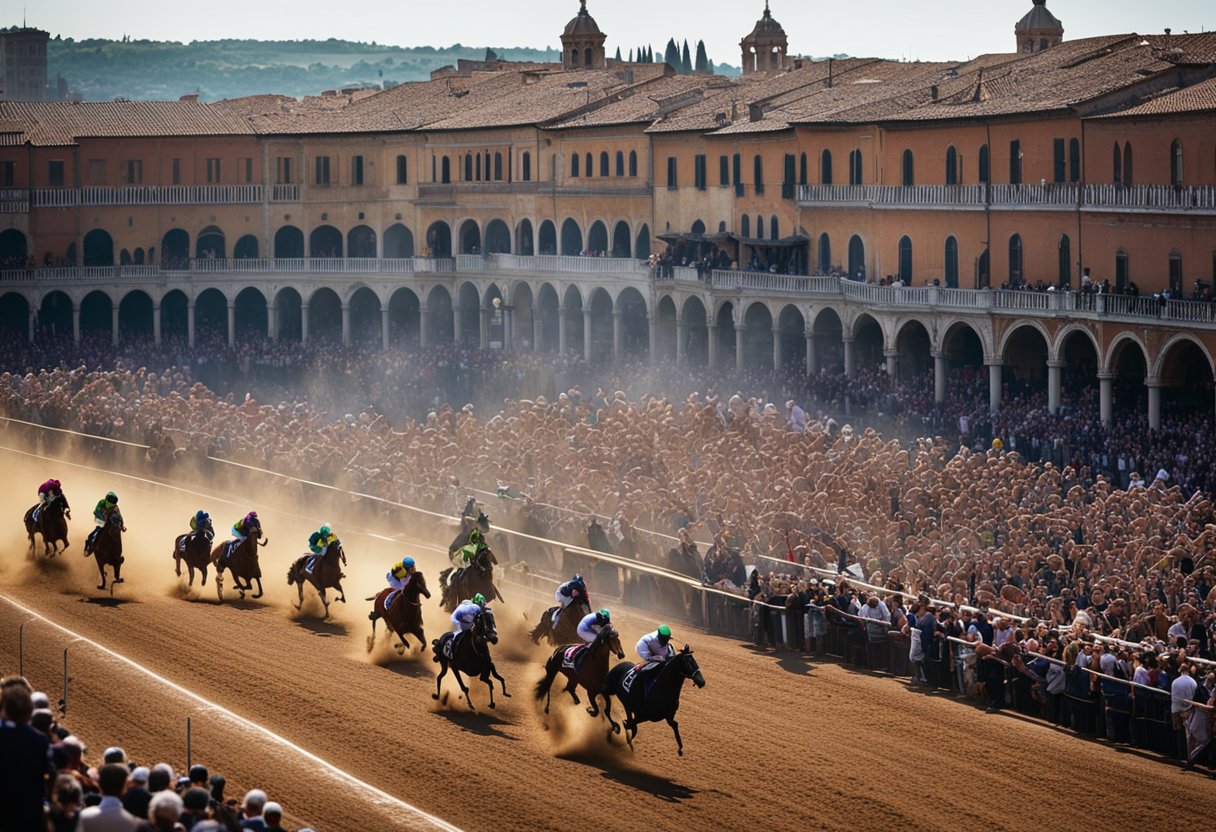
Updated On: April 04, 2024 by Raghda Elsabbagh
The Palio di Siena is not only Italy’s most famed horse race but a journey through the annals of history, reverberating with cultural significance. Steeped in tradition, this biannual event pits the city’s districts, known as contrade, against each other in a passionate display of neighbourhood pride and historic rivalry. With origins tracing back to the medieval ages, the race transforms the city’s Piazza del Campo into a thundering racetrack, echoing the vibrancy and valour of Siena’s storied past.

Immersing ourselves in the heart of Tuscany, we navigate the intricate web of the Palio di Siena’s history, from the military celebrations of its inception to the pageantry and competitiveness that define the event today. Each contrada, with its unique emblem and colours, prepares meticulously with its chosen horse and jockey, underscoring the race’s fusion of strategy, skill, and raw emotion. This spirited competition extends beyond the pursuit of victory; it embodies a sense of identity, community, and continuity, ensuring the legacy of Siena’s historical tapestry endures through each gallop and turn.
Table of Contents
Origins and Historical Significance of the Palio di Siena
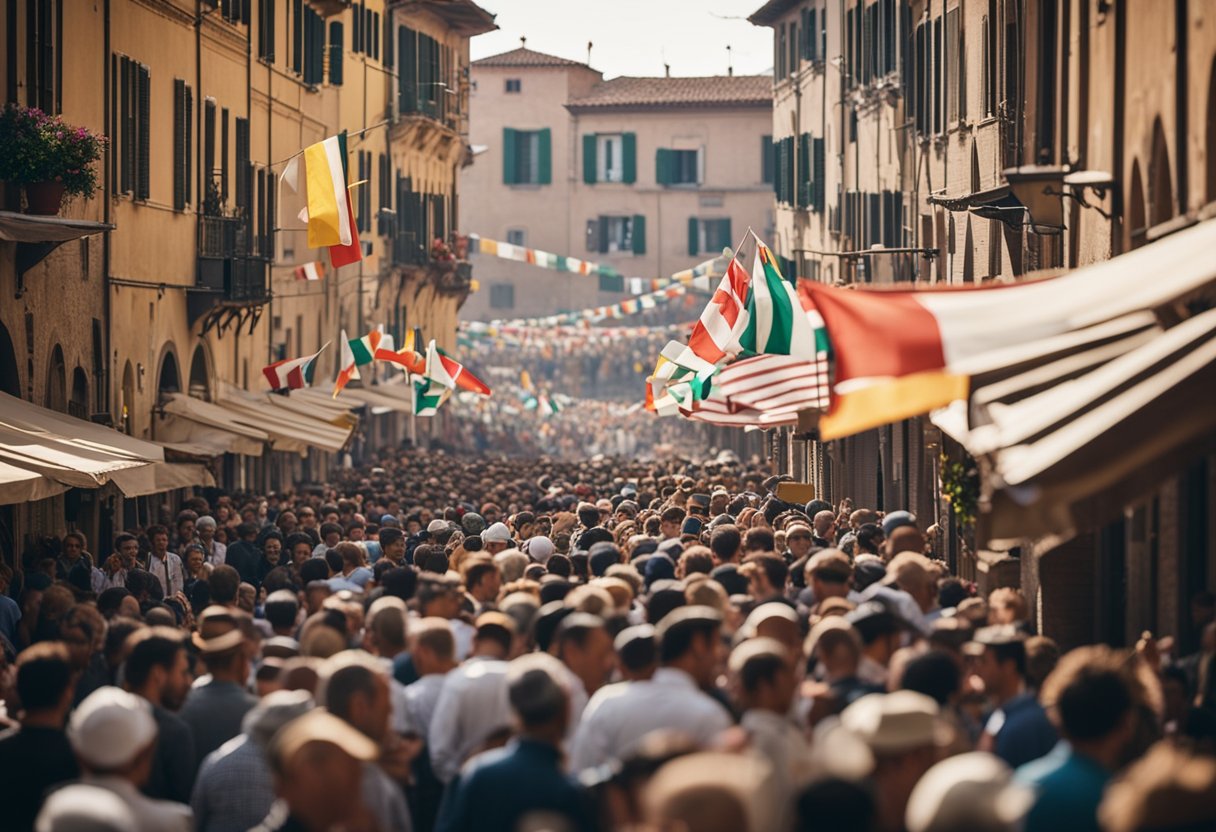
We explore the roots and enduring importance of the Palio di Siena, tracing its journey from medieval times to its current role as a cultural phenomenon that epitomises tradition and unity.
Medieval Beginnings
The inception of the Palio di Siena is deeply enmeshed in the medieval tapestry of Siena’s history. It was during the Middle Ages that this event began its life, a fierce competition that commenced in 1633, initially as part of religious festivities to honour the Assumption of Mary. From its formation, the Palio di Siena has been a centrepiece of local culture, a tradition carried through the centuries with unwavering passion and devotion.
Cultural and Political Evolution
Over time, the race transcended its religious connotations, becoming a source of unity and pride among the city’s districts or contrade. Each contrada is represented in the race, transforming the Palio di Siena into a striking display of communal identity and political significance. It remains a vibrant tradition reflecting the rich cultural fabric of Siena, a symbol that binds the present to its illustrious past while still evolving to maintain its relevance in contemporary society.
The Race and Its Rules
As we examine the Palio di Siena, it’s important to understand the unique aspects of the race and the specific rules that make it a significant event in the world of horse racing. The event revolves around a challenging course, the traditional bareback riding rules, and the critical role of the ‘mossa’.
The Course
The Palio is contested over three laps of the Piazza del Campo, Siena’s iconic shell-shaped central square. The course is notorious for its tight corners and the treacherous San Martino bend, testing both horse and rider to their limits.
Bareback Riding Rules
Competing bareback, riders must display exceptional skill and balance. A fall can lead to disqualification, but the race continues if a riderless horse completes the course—demonstrating that it’s very much the horse’s victory.
The Role of the ‘Mossa’
The ‘mossa‘ is Palio’s unique starting procedure, in which ten horses and riders line up between two ropes. Getting a favourable position at this stage is strategic, as it can greatly influence the outcome of the short yet intense race.
The Contrade: Heart of the Competition
The contrade of Siena are much more than just neighbourhoods; they are the vibrant epicentres of local identity and tradition, with rivalries and alliances shaping the thrilling Palio di Siena horse races every summer.
Significance of the Contrade
The contrade represents the core of the historic competition that takes over Siena twice a year. Each of the 17 districts is a microcosm of community spirit, festooned with its own unique emblems and colours. The races on 2 July and 16 August are not merely about the horses or the jockeys; they encapsulate the pride and collective soul of Sienese society.
The 17 Contrade and Their Symbols
The contrade of Siena each bear intriguing symbols that distinguish them:
- Oca (Goose)
- Tartuca (Turtle)
- Leocorno (Unicorn)
- Bruco (Caterpillar)
- Drago (Dragon)
- Torre (Tower)
- …and others, including Eagle, Forest, and Porcupine.
These icons are ubiquitously displayed throughout the year but take on a resplendent significance during the Palio season.
District Alliances and Rivalries
The alliances and feuds among the contrade define the dynamics of the Palio. Historical enmity, such as that between Oca and Torre, and the friendly ties known as ‘alli’ add a thick layer of intrigue to the races. A victory for one contrada is not just celebrated by its own residents but also by the allies who share in their triumph or consolation.
The Horses and Jockeys
In the Palio di Siena, the prowess of the horses and the skill of the jockeys are central to the success of each contrada. Each horse represents a chance for glory, and every jockey holds the weight of tradition and expectation.
Selection and Pre-race Rituals
The process of choosing Palio di Siena horses is meticulous, with a focus on their provenance and abilities. These mixed-breed horses are suited to the rigours of the race, and their selection is a crucial event known as the ‘segnatura dei fantini’, where jockeys are also matched with their horses. Prior to the race, a series of trials ensure each horse-jockey pairing is optimally prepared. Pre-race rituals are steeped in superstition and involve blessings and parades, reflecting the historical significance imbued within the event.
Jockey Strategies and Bribery
Jockeys employ various strategies to navigate the treacherous track of Piazza del Campo. Their experience and intimate knowledge often dictate the tactics used during the race. Bribery, though controversial, has historically played a part in the strategising, with jockeys and their affiliated contrade negotiating alliances. The municipality oversees these aspects to maintain the integrity of what is not only a competition but a profound cultural tradition.
Ceremonies and Festivities
The Palio di Siena is an event that comes alive with its elaborate ceremonies and festivities. Each moment is steeped in tradition, from the historic parade to the religious observances that lend the festival its profound sense of heritage.
Historical Parade
The corteo storico, a pageant that precedes the Palio race, is a magnificent display of Siena’s rich history. Revellers don medieval costumes, transforming the city into a vibrant tableau of the past. This historic parade showcases the pride of Siena, with each contrada, or district, represented by flag bearers and musicians. We witness a procession that connects us to the people of the Renaissance, celebrating the commune’s storied legacy.
Religious Significance and Celebrations
Religion intertwines with celebration, infusing the Palio with a deeper meaning. The festival honours the Madonna of Provenzano in the July race and is inextricably linked to the Feast of the Assumption in August. Each contrada pays homage to its patron saints through solemn prayers and joyous festivities. This blend of devotion and community spirit is a cornerstone of the event, embodying the shared faith and cultural identity of Siena’s residents.
The Prize: Beyond the Victory
In Siena’s cultural tapestry, victory in the Palio is a testimony to the pride and spirit of the city’s contrade. The prizes are a symbol of honour and are greatly revered.
The Drappellone
The Drappellone, often called the ‘pallium’, is the most coveted prize awarded to the victorious contrada. It is a large, painted silk banner, artistically crafted and imbued with significant meaning. Each year, a different artist is commissioned to create this unique trophy, making it a one-off piece of art. Due to its bespoke nature, the Drappellone is not only a trophy but also a historical record of the event, and as such, it is often displayed in a local museum or contrada’s headquarters.
Winning the Drappellone is a matter of immense pride for the contradaioli, the members of the winning district. It is a tangible reminder of their triumph and a symbol that unites and energises the community. The banner is often paraded through the streets of Siena, and large celebrations accompany it.
Significance for the Winning Contrada
The impact of winning the Palio extends far beyond the physical display of the Drappellone. For the winning contrada, the prize symbolises a year’s worth of bragging rights and communal jubilation. It enriches the historical legacy and the bonds among its members. Following the victory, it’s common for the contrada to organise celebratory banquets and events that can last for weeks, strengthening community ties and fostering a sense of shared achievement.
Race Days: A City Transformed
The Palio di Siena is not just a horse race; it’s a transformative event for the city, immersing Sienese and visitors alike into a captivating atmosphere of anticipation and celebration.
Preparation and Anticipation
In the days leading up to the Palio, Siena is abuzz with excitement. Preparation is meticulous as each contrada, or district, painstakingly selects and trains their horse. The selection process is feverish, with horses chosen for both the 2 July race, which is dedicated to the Madonna di Provenzano, and the August Palio, which honours the Feast of the Assumption.
Each contrada adorns its neighbourhood in its colours, flags fluttering high. The anticipation mirrors the fervour of times past, embodying a living tradition that transcends centuries. Historical allegiance and civic pride culminate in banquets and religious ceremonies as people of all ages gather in a shared, electric preparation for the race days.
Atmosphere on Race Days
On race days, Siena transforms into a spectacle of hues and sounds. The atmosphere is a feast for the senses; spirited rhythms of drums and the swirl of flags fill the air as Sienese dressed in traditional garb parade through the city. The clamour and passion of the crowds build to an apex, embodying the spirit of communal festivity.
The festivities reach a crescendo when the famed Piazza del Campo, shaped like a shell and layered with tufa, becomes the stage for the storied contest. Here, the Sienese and tourists alike are enveloped in a wave of emotions as ten horses and riders, bareback and hearts ablaze with the prospect of victory, hurtle around the piazza. It’s more than a race; it is the heartbeat of Siena, reflective of its rich tradition and living history.
The July and August Palio are not simply dates on a calendar; they mark days when Siena is reborn into its glorious, historical persona — a testament to the enduring cultural fabric of this city.
Controversies and Dangers
In the illustrious history of the Palio di Siena, it is not without its share of controversies and dangers that concerns and debates are raised each year.
Accidents and Animal Rights
Accidents: The Palio di Siena is infamous for the thrills it presents, not just to spectators but also to the horses and jockeys racing. Given the narrow streets and sharp curves of Piazza del Campo, accidents are a distressing yet frequent occurrence.
Animal Rights: Moreover, the high-intensity race in such challenging conditions has drawn criticism from animal rights activists. There have been calls for changes to protect the equine participants, as the race has, tragically, led to injuries and even fatalities among the horses.
Political and Financial Disputes
Government and Tradition: The event, while steeped in tradition, is not free from political entanglements and financial disputes. The involvement of the government often comes into question, especially pertaining to the balancing act between maintaining tradition and ensuring safety.
Controversies: Financial aspects also introduce controversies, as betting on the outcome is a common practice, sometimes leading to heated disagreements and claims of race fixing, further complicating the social and cultural fabric that surrounds this historic event.
Symbols and Iconography
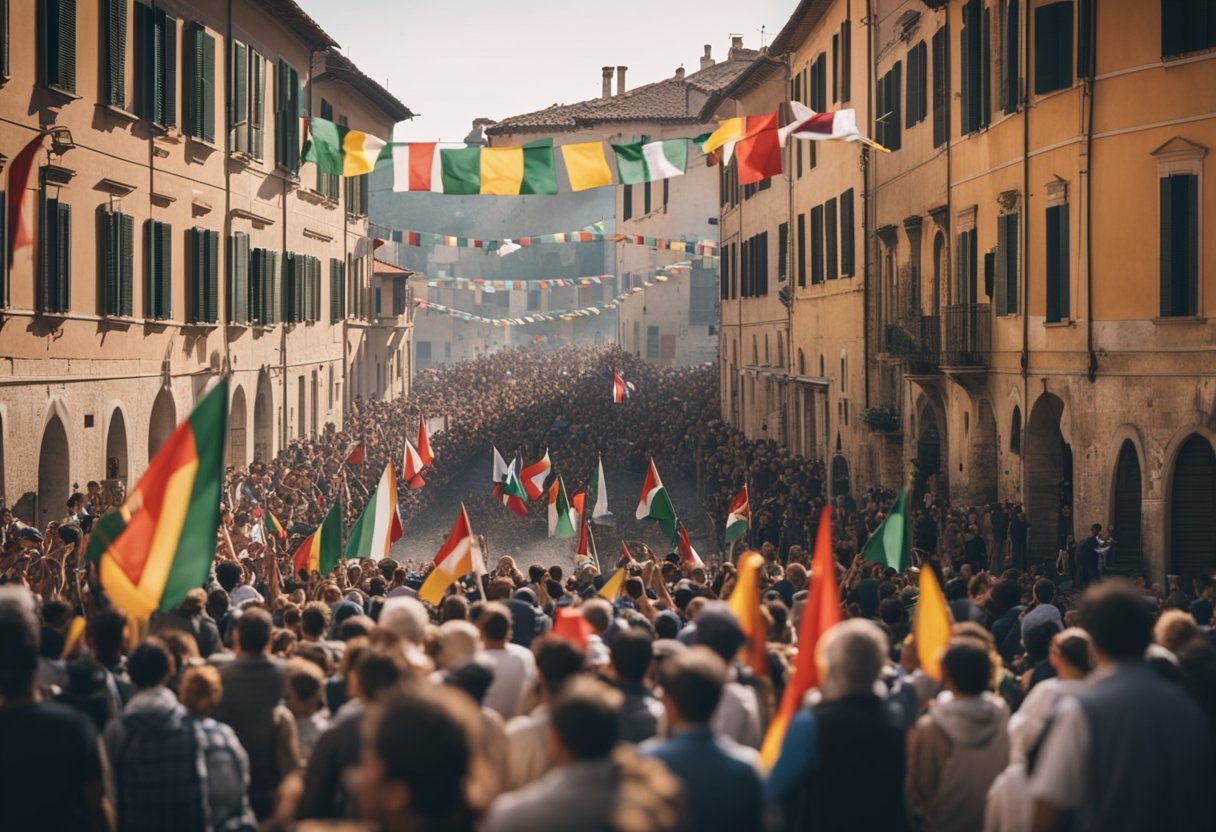
In the vibrant tradition of the Palio di Siena, symbols and iconography play an essential role, each rich with meaning and history. Here, we explore the specific emblems and colours that define the identity of each contrada, as well as the spectacle of the flag throwers and drummers that bring the event to life.
Emblems and Colours
Each of the seventeen contrade participating in the Palio di Siena has unique emblems and colours, which are a source of pride and identity for their inhabitants. These emblems often feature animals or symbols that have historical significance or mythological connections.
For example, the contrada of the Eagle proudly displays a black eagle against a yellow and red background, embodying the power and nobility of the creature. In contrast, the Snail contrada opts for a more whimsical motif, featuring a white snail on a blue and yellow backdrop. Both the emblems and their associated colours are displayed throughout the district, especially during the Palio, and are worn with pride by the contrada members.
Flag Throwers and Drummers
The flag throwers and drummers are pivotal to the festival’s pageantry, their performances echoing medieval traditions and providing a rhythmic backdrop to the event. The flag throwers, known as ‘alfieri’, execute a choreography of twirls and tosses, their flags emblazoned with the unique symbols of their respective contrade. This requires immense skill, for flags are not only tossed individually but also exchanged amongst the alfieri in breathtaking sequences.
The drummers, clad in historical costumes reflective of their contrada’s colours, contribute to the festive atmosphere with thunderous beats. This combination of precise flag choreography and stirring percussion encapsulates the spirit of the Palio, a testament to the enduring cultural heritage of Siena.
Impact on Siena and Beyond
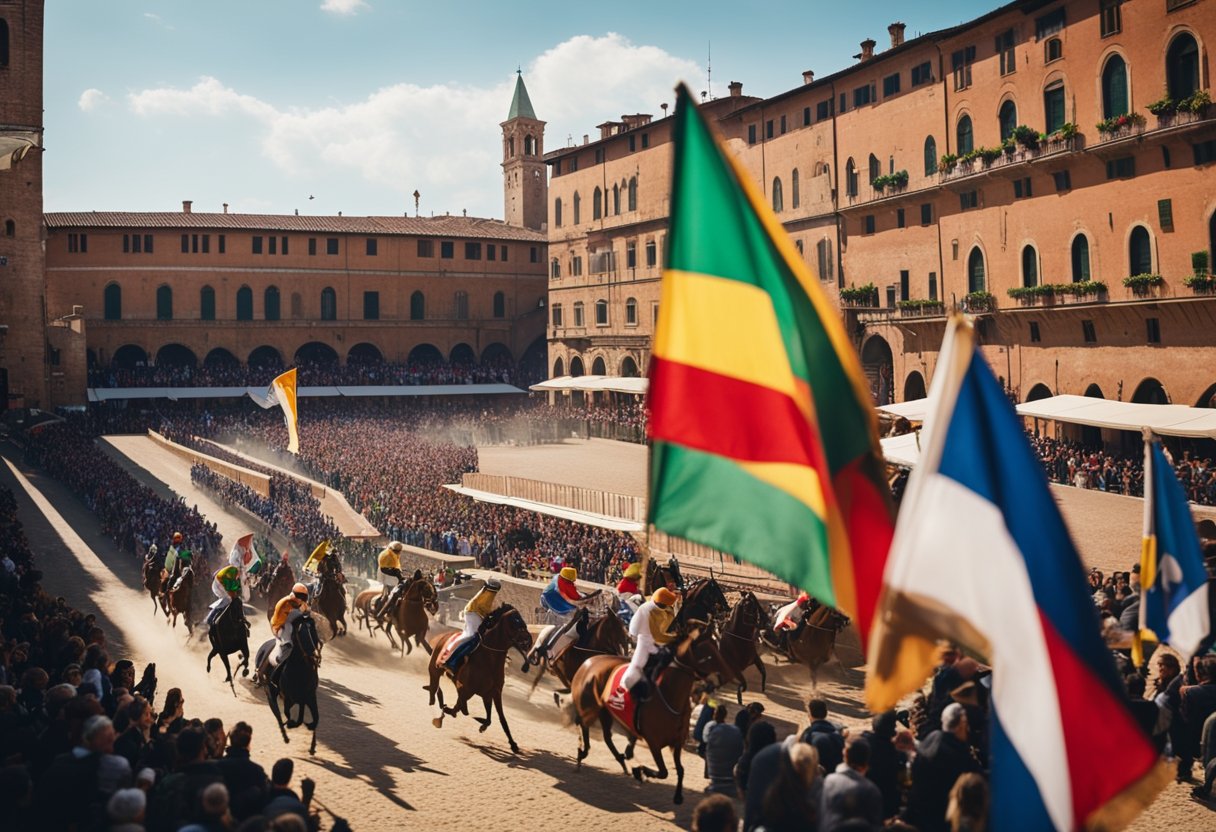
The Palio di Siena is not merely a horse race; it is a pillar of Siena’s identity and a significant draw for tourism, bringing both cultural enrichment and economic benefit to the region.
Cultural Significance
The Palio di Siena is deeply ingrained in Siena’s cultural fabric. Taking place in the iconic Piazza del Campo, the event is a manifestation of ancient customs and communal identity. It hearkens back to the medieval period, transforming the city into a tapestry of historic pageantry. The Palio instils a sense of belonging among the contrade, or districts, as they compete with fervour and passion, each vowing to uphold their heritage.
Tourism and Economy
The economic impact of the Palio on Siena and Tuscany at large is substantial. As a major event, it draws visitors from across Italy and the globe, significantly boosting local tourism. Hotels, restaurants, and shops experience a surge in patronage during the races, held on 2 July and 16 August each year. This influx of tourism not only benefits the immediate economy but also promotes Siena as a cultural hub to an international audience.
Frequently Asked Questions
In this section, we address some of the most common queries about the Palio di Siena, offering insights into its historical significance, cultural importance, and how it continues to captivate audiences worldwide.
Why is the Palio di Siena celebrated each year?
The Palio di Siena is celebrated to uphold a centuries-old tradition, honouring both the rich history of Siena and its vibrant community. This event, deeply woven into the city’s fabric, showcases the fierce rivalry and pride of the Contrade.
How have the traditions of the Palio di Siena evolved over time?
Traditions of the Palio have been shaped over the centuries, with the event transitioning from a celebration of military victories to the famed horse race it is today. The customs have largely remained intact but have been refined to integrate more safety measures and regulations.
What are some notable facts about the Palio di Siena’s history?
A notable fact about the Palio’s history is that it dates back to the medieval era, with the first race being held in the 1600s. Originally, one race was held annually, with a second added in the 18th century, creating the biannual celebration that exists today.
Which is considered the most prestigious horse race in Italy?
The Palio di Siena is considered the most prestigious and historically significant horse race in Italy. It not only is a display of equestrian skill but also a manifestation of local tradition and fierce district pride.
What significance does the Palio hold in the context of Italian culture?
In the context of Italian culture, the Palio is a representation of community identity and historical continuity. It is more than a mere sporting event; it is a living tradition that strengthens bonds among residents and celebrates their shared heritage.
How can one obtain tickets to watch the Palio di Siena?
Tickets can be procured through various channels, including official ticket outlets, or possibly by contacting the Contrade directly to watch the Palio di Siena. It’s advisable to book well in advance due to the event’s popularity.



